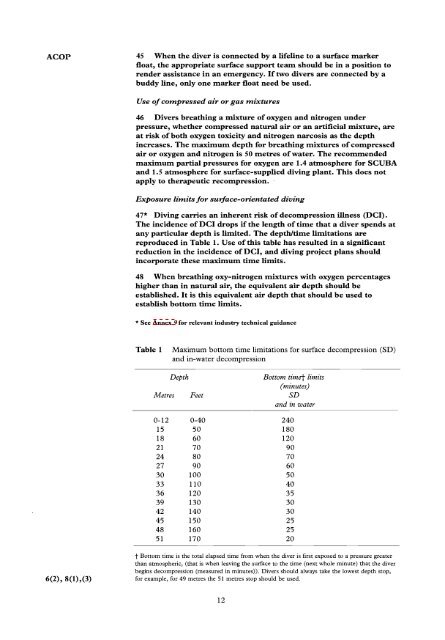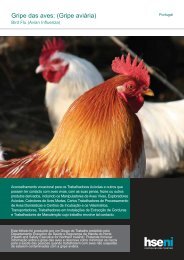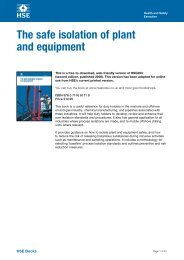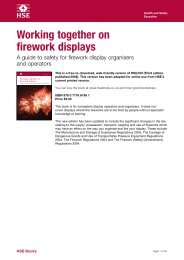Commercial diving projects inland/inshore - Health and Safety ...
Commercial diving projects inland/inshore - Health and Safety ...
Commercial diving projects inland/inshore - Health and Safety ...
Create successful ePaper yourself
Turn your PDF publications into a flip-book with our unique Google optimized e-Paper software.
ACOP 45 When thediver is connectedby alifeline to a surfacemarker<br />
float,the appropriatesurfacesupportteam should be in a positionto<br />
render assistance in an emergency. Iftwo divers are connectedby a<br />
buddyline, only one marker floatneed be used.<br />
6(2),8(1),(3)<br />
Use ofcompressedairorgas mixtures<br />
46 Divers breathingamixture ofoxygen <strong>and</strong> nitrogenunder<br />
pressure, whethercompressednatural air oran artificialmixture, are<br />
atrisk ofboth oxygentoxicity<strong>and</strong>nitrogennarcosisasthe depth<br />
increases.The maximumdepth forbreathingmixtures ofcompressed<br />
air or oxygen<strong>and</strong> nitrogenis 50 metres of water.The recommended<br />
maximumpartial pressuresfor oxygenare 1.4 atmosphereforSCUBA<br />
<strong>and</strong> 1.5 atmospherefor surface-supplied<strong>diving</strong> plant. This does not<br />
applyto therapeuticrecompression.<br />
Exposurelimitsforsurface-orientated<strong>diving</strong><br />
47* Diving carries an inherent risk ofdecompression illness(DCI).<br />
The incidence ofDCI dropsifthelength oftime thata diver spendsat<br />
any particular depthis limited.The depth/time limitationsare<br />
reproducedin Table 1. Useofthis tablehas resultedin a significant<br />
reductionin the incidence ofDCI, <strong>and</strong> <strong>diving</strong> projectplans should<br />
incorporatethese maximumtime limits.<br />
48 When breathingoxy-nitrogen mixtureswith oxygenpercentages<br />
higher than innatural air, the equivalent air depthshouldbe<br />
established. Itisthis equivalent air depththat should be usedto<br />
establish bottom time limits.<br />
* See Annex5 forrelevant industry technical guidance<br />
Table 1 Maximum bottomtime limitations for surface decompression (SD)<br />
<strong>and</strong> in-water decompression<br />
Depth<br />
Metres Feet<br />
Bottom timet limits<br />
(minutes)<br />
SD<br />
<strong>and</strong>in water<br />
0-12 0-40 240<br />
15 50 180<br />
18 60 120<br />
21 70 90<br />
24 80 70<br />
27 90 60<br />
30 100 50<br />
33 110 40<br />
36 120 35<br />
39 130 30<br />
42 140 30<br />
45 150 25<br />
48 160 25<br />
51 170 20<br />
t Bottom timeisthetotalelapsed time from when thediver is first exposedto a pressure greater<br />
thanatmospheric, (that iswhen leavingthesurface to thetime(next whole minute) that thediver<br />
begins decompression(measured in minutes)). Divers should always take the lowestdepthstop,<br />
forexample, for49 metres the 51 metres stopshould be used.<br />
12







